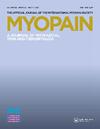The Effects of Self-Efficacy on Depression and Pain in Fibromyalgia Syndrome: Does Initial Depression Matter?
引用次数: 15
Abstract
Abstract Objective: Fibromyalgia syndrome [FMS] is a chronic pain condition of unknown etiology. Non-myalgic aspects of the disorder have become increasingly focal in its evaluation. Research has suggested that subgrouping FMS patients based on factors other than pain may abet diagnostic and interventional processes. Self-efficacy and depression are two such constructs that appear to be important in FMS. However, it is not known whether the consequentiality of self-efficacy in FMS is dependent on depression. The present study examined the pathways among depression, self-efficacy and pain, in a large sample of depressed and non-depressed FMS patients over a one-year timeframe to determine whether differential relationships existed. Method: Participants completed assessments of pain intensity, depression and self-efficacy at baseline, 6 months and 1 year as part of an intervention study. Approximately half of the participants met the cutoff for depression in chronic pain populations on the Centers for Epidemiologic Studies Depression Scale. Results: Participants who were depressed at baseline experienced a general decline in pain intensity and depression, whereas depression and pain for non-depressed participants appeared to be far more stable across time. Though self-efficacy was a significant predictor of changes in both pain and depression for depressed participants, self-efficacy did not predict changes in pain for non-depressed participants. Conclusion: Our findings support subgrouping FMS patients based on psychological factors. The results indicated that relationships between pain, depression and self-efficacy differed between depressed and non-depressed participants, implying that individuals with FMS and depression may benefit most from interventions that aim to decrease lability and increase self-efficacy for the most challenging times.自我效能感对纤维肌痛综合征患者抑郁和疼痛的影响:初始抑郁是否重要?
摘要目的:纤维肌痛综合征(FMS)是一种病因不明的慢性疼痛病症。非肌痛方面的疾病已成为越来越多的焦点在其评估。研究表明,根据疼痛以外的因素对FMS患者进行亚组可能有助于诊断和介入治疗。在FMS中,自我效能感和抑郁是两个很重要的构念。然而,目前尚不清楚FMS中自我效能的结果是否依赖于抑郁。本研究在一年的时间框架内,对大量抑郁和非抑郁FMS患者样本进行了研究,以确定是否存在差异关系。方法:作为干预研究的一部分,参与者在基线、6个月和1年完成疼痛强度、抑郁和自我效能的评估。大约一半的参与者符合流行病学研究中心抑郁量表中慢性疼痛人群抑郁的临界值。结果:基线时抑郁的参与者疼痛强度和抑郁程度普遍下降,而非抑郁参与者的抑郁和疼痛随着时间的推移似乎更加稳定。虽然自我效能感是抑郁参与者疼痛和抑郁变化的重要预测因子,但自我效能感并不能预测非抑郁参与者的疼痛变化。结论:本研究结果支持基于心理因素对FMS患者进行亚组。结果表明,在抑郁和非抑郁的参与者中,疼痛、抑郁和自我效能之间的关系是不同的,这意味着在最具挑战性的时期,FMS和抑郁症患者可能从旨在降低不稳定性和提高自我效能的干预中获益最多。
本文章由计算机程序翻译,如有差异,请以英文原文为准。
求助全文
约1分钟内获得全文
求助全文

 求助内容:
求助内容: 应助结果提醒方式:
应助结果提醒方式:


